Singapore is undoubtedly a popular destination for Australian travellers. But funnily enough, its airport is something of a destination in its own right. Changi Airport is home to Jewel – accessible by the public even when not flying. And then airside, there’s a butterfly garden, movie theatre, playground and more.
Changi also sports a wide array of airport lounges. Being such a premium business destination, many airlines put their best foot forward. Qantas alone operates two separate lounges here. And, of course, as Singapore Airlines’ home hub, the carrier offers an impressive seven lounges across two terminals.
This guide will walk you through all of your lounge options in Singapore and the various facilities that Changi Airport has to offer.
Changi Airport Layout
Singapore’s Changi Airport has four terminals. T1, T2 and T3 are all interconnected, which means you can go anywhere within those three terminals after immigration. It’s possible to walk between them, or you can take the Skytrain to speed things up. But this has an added advantage: it opens the door to more shopping and lounge-hopping opportunities. Terminal 4 is in a separate secure area and requires a bus ride.

Australians will most likely use Terminal 3 for Singapore Airlines flights. Otherwise, Terminal 1 is generally the go-to. It’s home to Qantas, British Airways, Emirates, Scoot and Turkish Airlines – all of which fly to Australia. For Singapore Airlines, Terminal 2 is generally more for regional Asian departures.
Terminal 4 is the newest and hosts Jetstar, Jetstar Asia, Cathay Pacific and AirAsia as the main airlines. It is connected to T1/2/3 shuttle bus services from other terminals. However, you may require a Terminal 4 boarding pass to access the terminal.
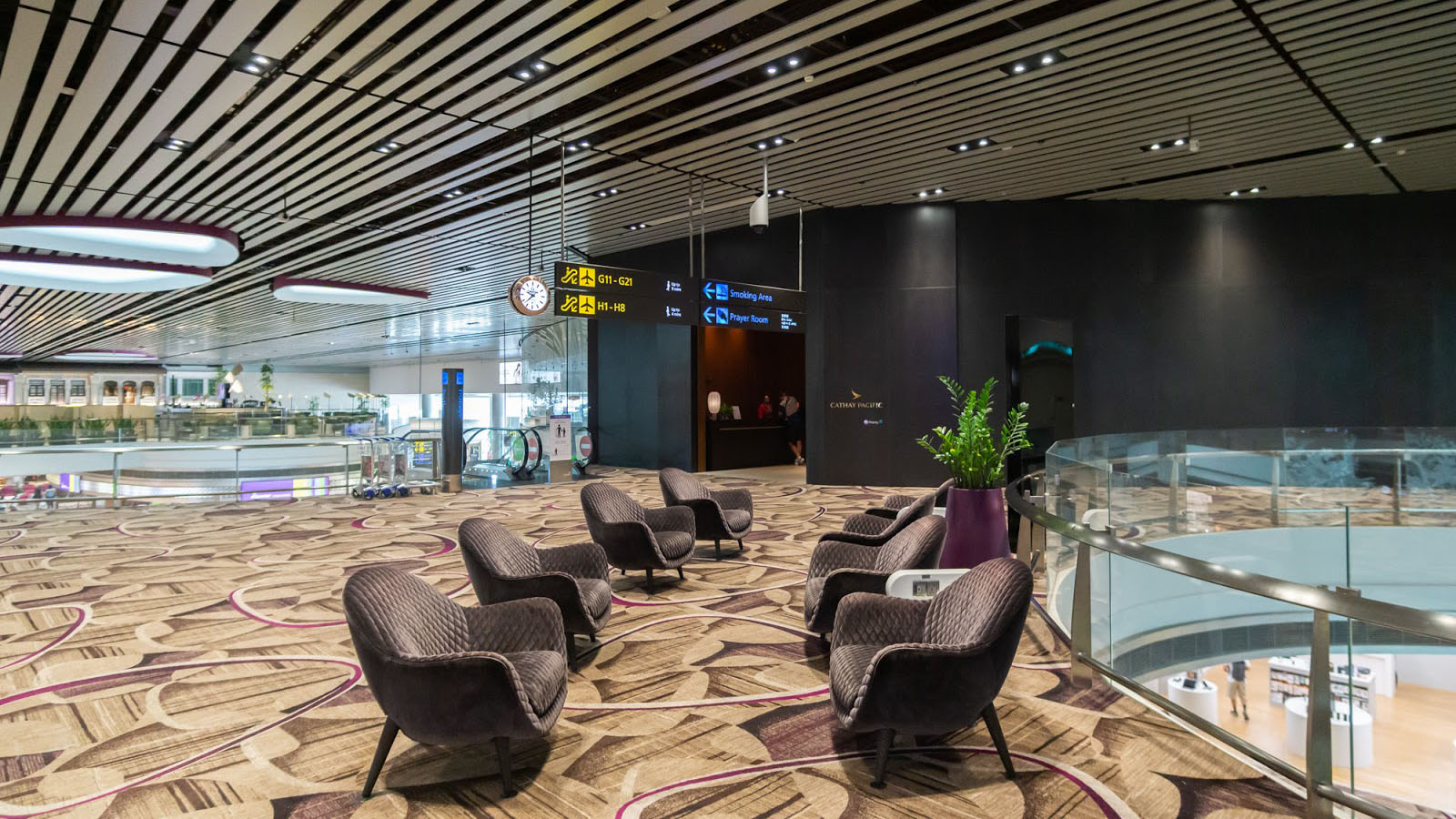
However, it might be possible the other way around. For example, a Cathay Pacific passenger with oneworld Emerald status could technically check-in at Jewel for the boarding pass. Then, cross immigration at T1 to use the Qantas First Lounge, and later, take the airside bus transfer to T4 from gate C21 in Terminal 1. This is a little bit fiddly, so we wouldn’t recommend it unless arriving at the airport with a lot of time to spare.
Point Hacks has reviewed most of the major lounges in Singapore Changi Airport, so read on for more information!
Terminal 1
Qantas, British Airways, Emirates and Scoot depart from Terminal 1. T1 is also home to most oneworld Alliance airlines in Singapore. Jewel is also directly connected with Terminal 1.
Use the screens in the terminal to find your airline’s check-in zone. Or, go one better and swing by the early check-in facility at Jewel. This allows you to check-in any luggage and obtain a boarding pass many hours before your flight’s scheduled departure time.
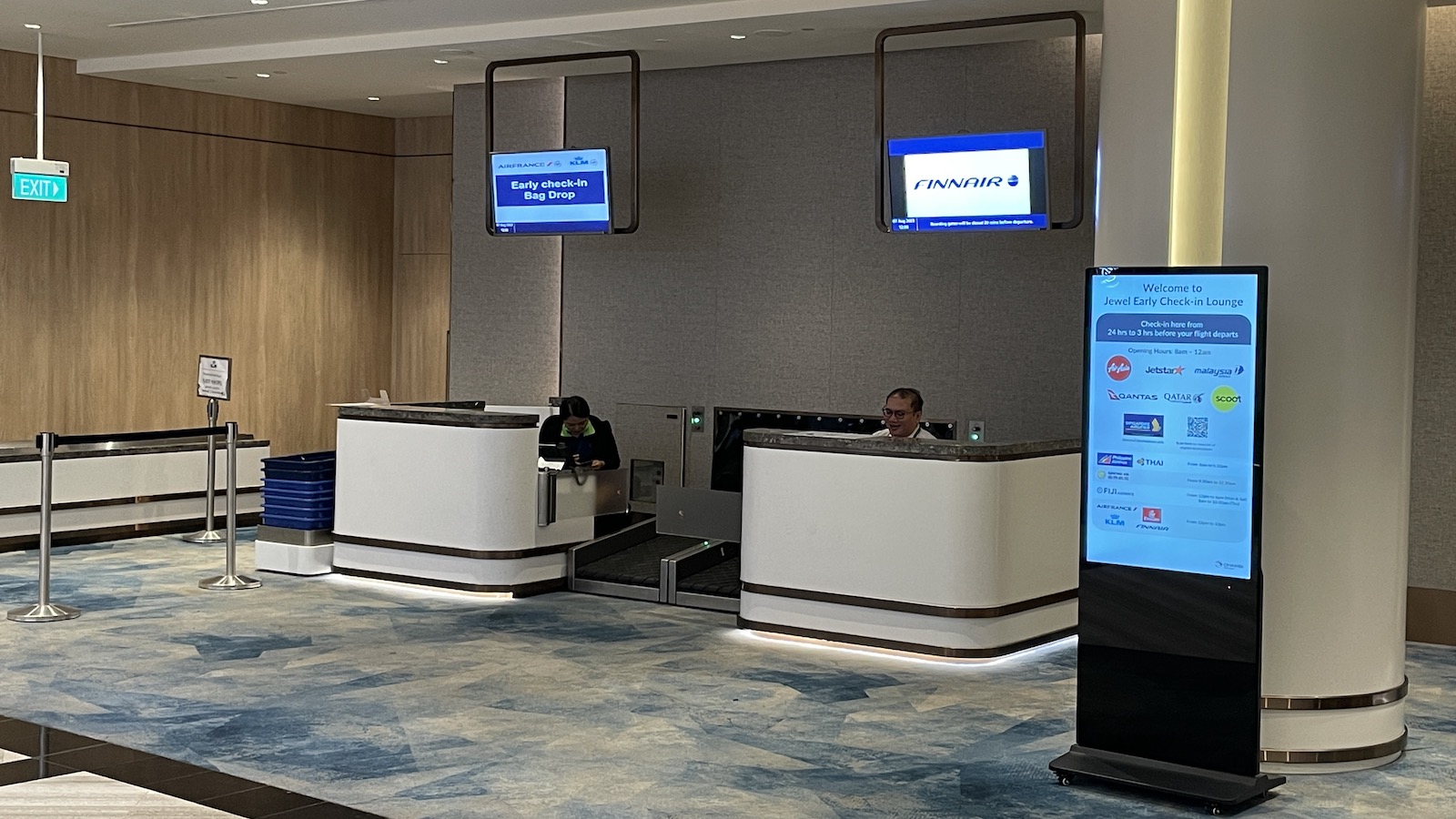
Immigration takes place straight after check-in, although security screening is at the gate. Once you’re through immigration, to the left are the C Gates and many of the lounges mentioned below. To the right is the D Gates, where an Aerotel transit hotel and Qantas First Lounge are located.
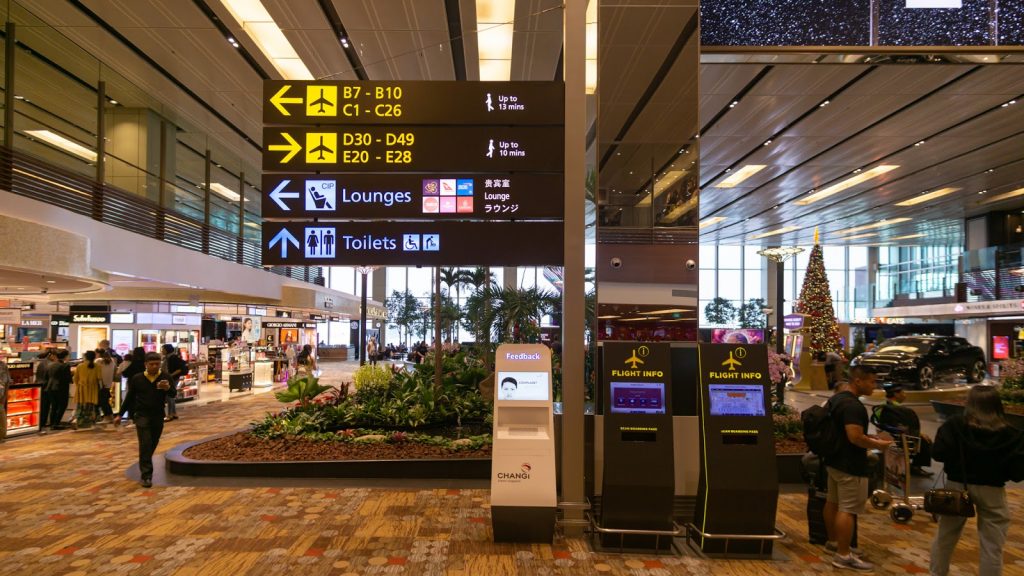
Notable Lounges and Hotels:
- Qantas International Business Lounge
- Qantas International First Lounge
- Emirates Lounge
- British Airways Lounge
- Qatar Airways Premium Lounge
- Marhaba Lounge
- Plaza Premium Lounge Singapore
- SATS Premier Lounge T1
- Aerotel Transit Hotel (after immigration)

The Skytrain connects Terminal 1 to Terminal 3 near the C Gates, and Terminal 1 to Terminal 2 near the D Gates. Security screening is done at individual gates, so leave time for that before boarding.
Terminal 1 has the Aerotel, which is an airside transit hotel with a swimming pool and fitness room. They charge from six-hour blocks onwards, so it could be a great option for taking a break in transit. You can also buy access to the pool and shower for a refresh.
Terminal 2
Terminal 2 mainly serves Singapore Airlines’ regional flights. As one of Changi Airport’s original terminals, it does have an older – and admittedly, more cramped – feel.
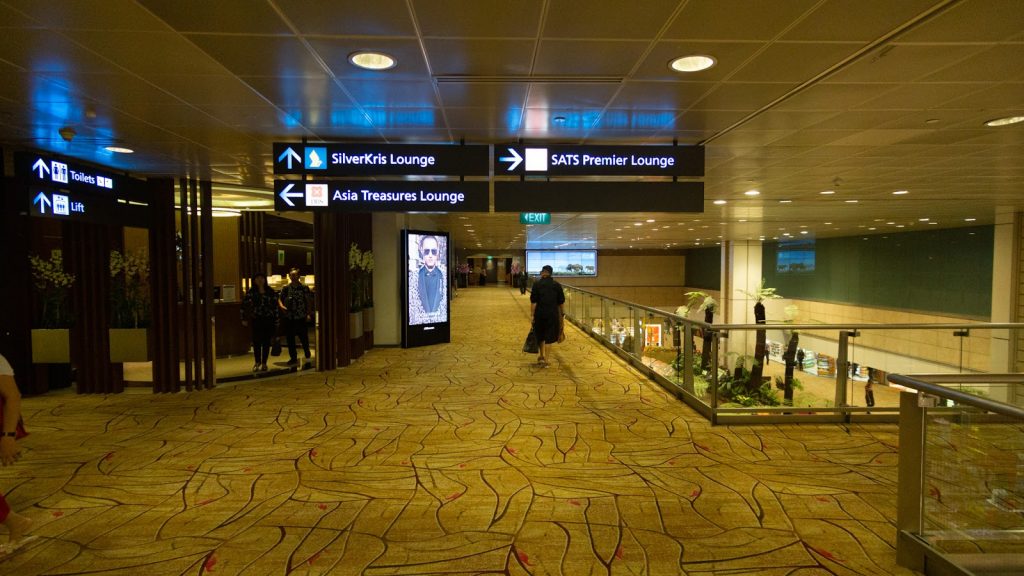
Notable Lounges and Hotels:
- Ambassador Transit Lounge + Hotel
- SATA Premier Lounge
- Singapore Airlines’ regional KrisFlyer Gold, SilverKris and First Class lounges
Terminal 2 has a central garden atrium with a koi pond, which is quite relaxing to watch. If you can brave the heat, outside there is a sunflower garden as well.
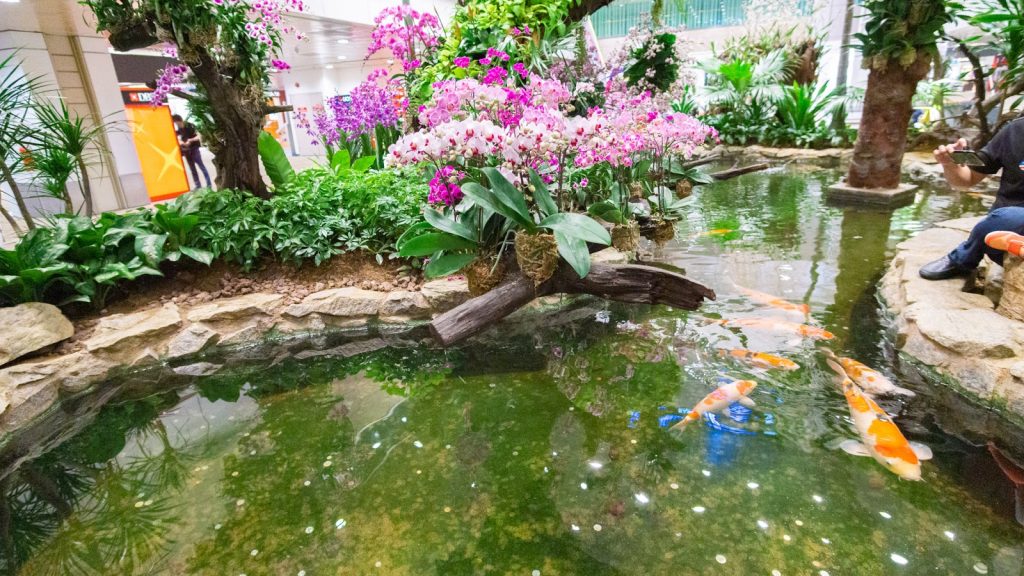

Terminal 2 is also home to some unique facilities such as an ‘Entertainment Zone’ also for kids – although for now, it’s ‘temporarily closed’.
From Terminal 2, there are two Skytrains to T3 (one from the F-Gates and one from the E-Gates which goes through Jewel). There’s also a Skytrain to T1 from the E-Gates. From the public side, there is a direct link bridge to Jewel as well.
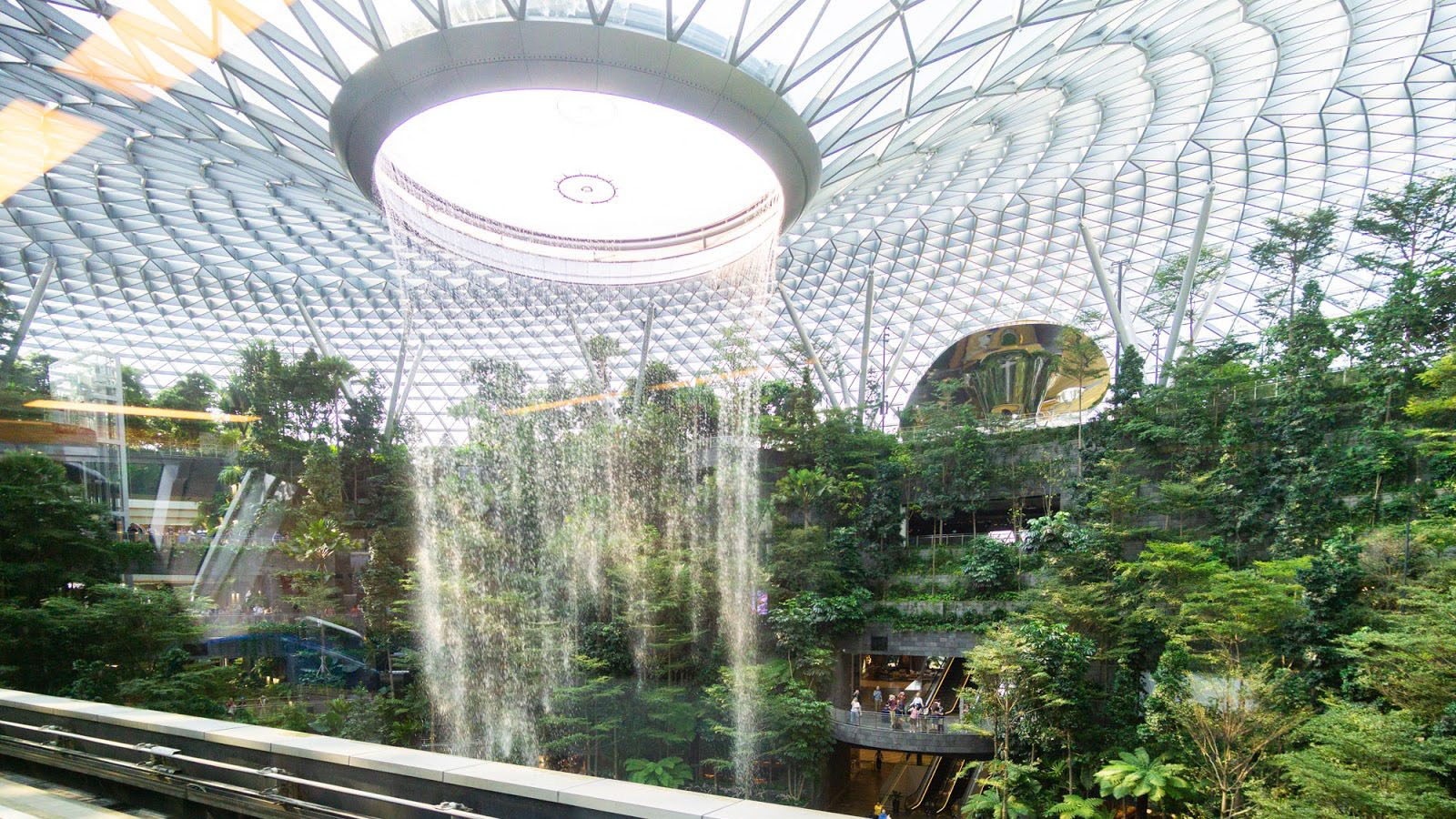
Finally, T2 is also the hub to transfer to the newer Terminal 4, which is located off-site. If you’re in transit and have a valid boarding pass for Terminal 4, head to Gate F51 in Terminal 2 for security screening and the airside transit bus.
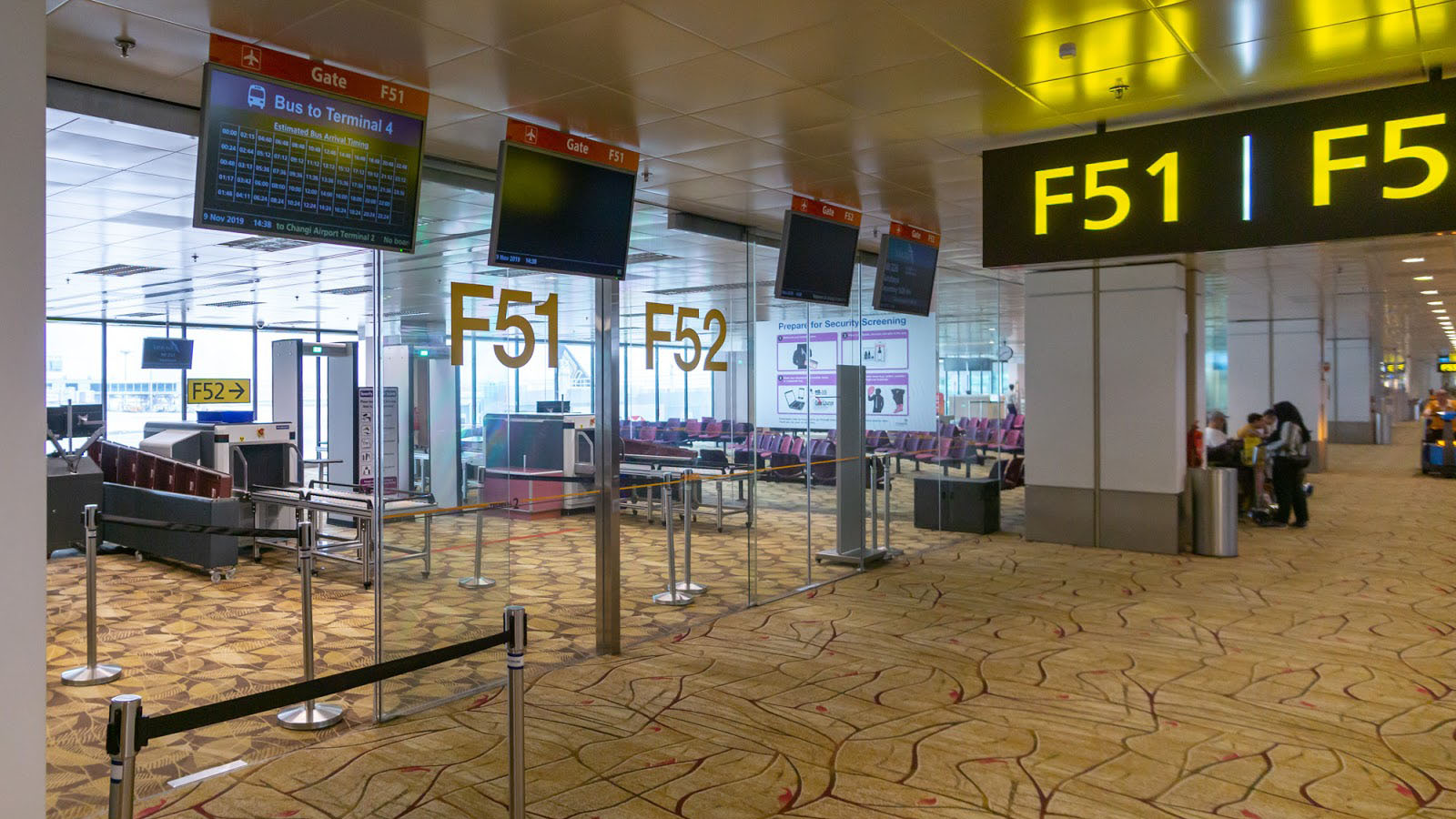
There’s also a free public shuttle bus landside that stops at various locations.
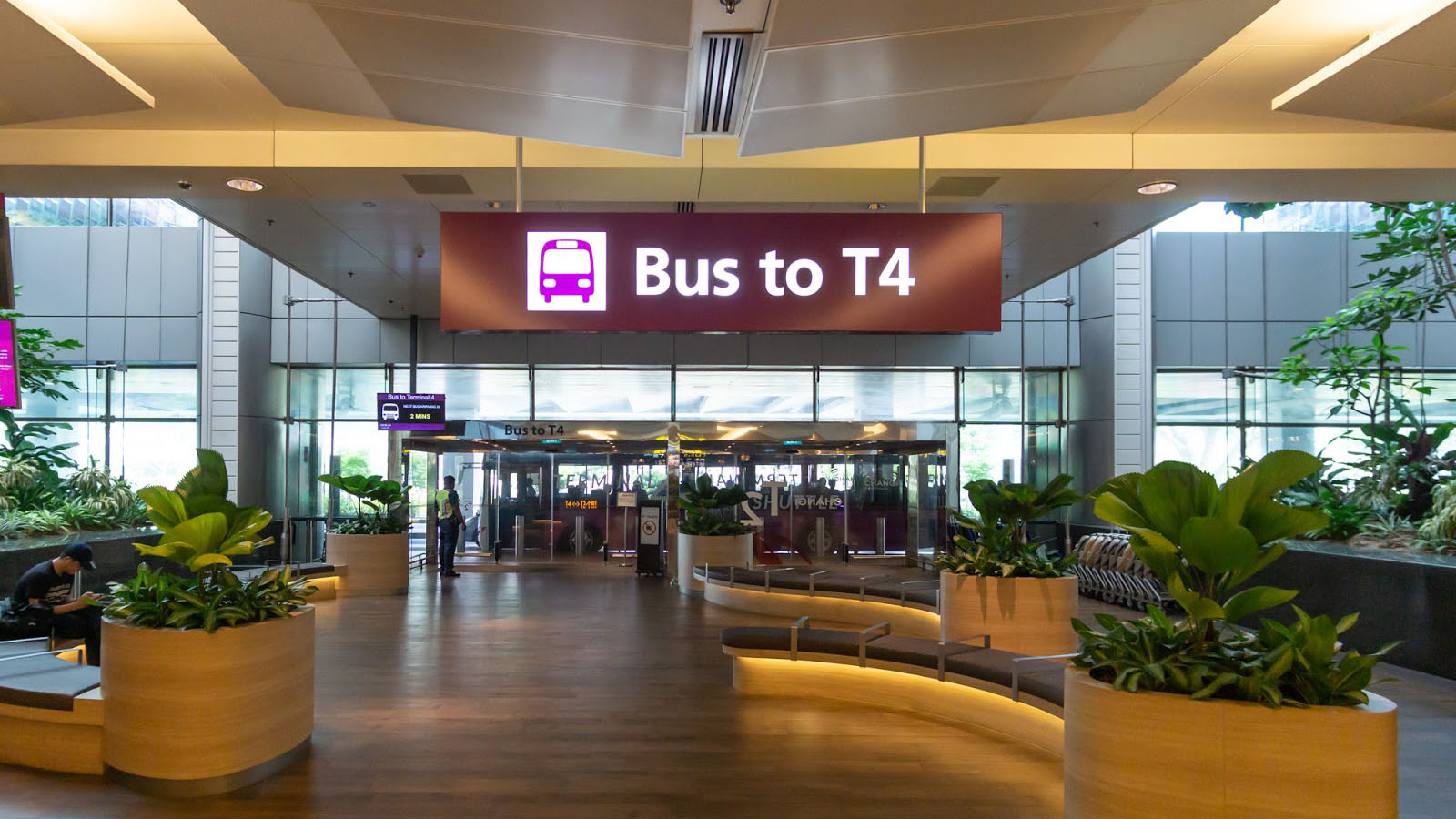
Terminal 3
Changi Terminal 3 is the one you’ll most likely encounter if you’re on Singapore Airlines’ many flights to Australia and on to Europe and other faraway cities.
It’s a newer terminal designed for Singapore Airlines with a private First Class kerbside check-in area and its unique The Private Room lounge for First Class passengers.
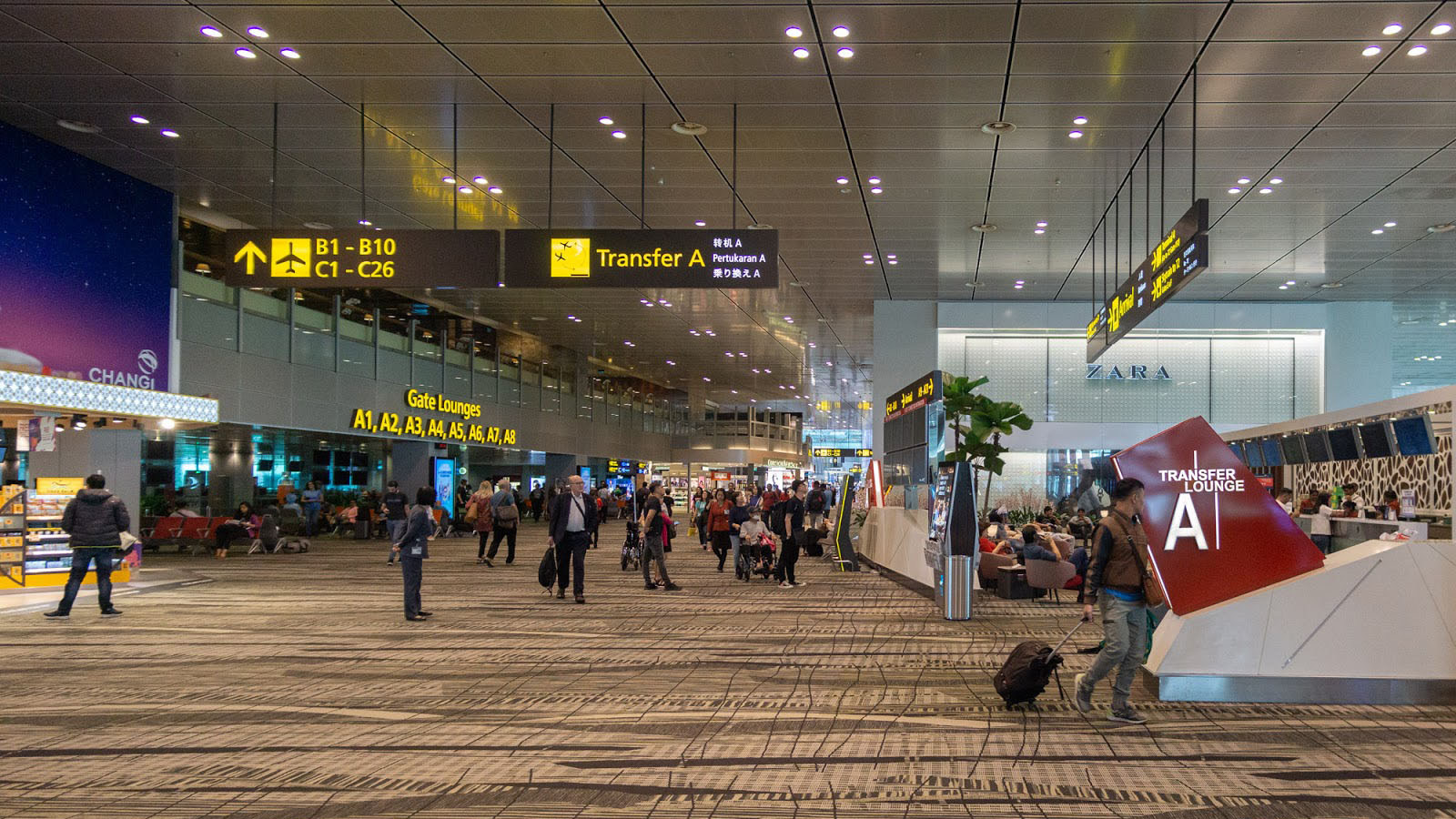
Notable Lounges and Hotels:
- Singapore Airlines SilverKris Business Class, SilverKris First Class and The Private Room lounges
- Singapore Airlines KrisFlyer Gold Lounge
- Marhaba Lounge
- SATS Premier Lounge
- Ambassador Transit Lounge + Hotel
After immigration, you’ll be front and centre in the shadow of Louis Vuitton’s flagship store. For lounge passengers, the Singapore Airlines SilverKris lounges, The Private Room and SATS Premier Lounge are to your left, and the Marhaba Lounge is to your right.
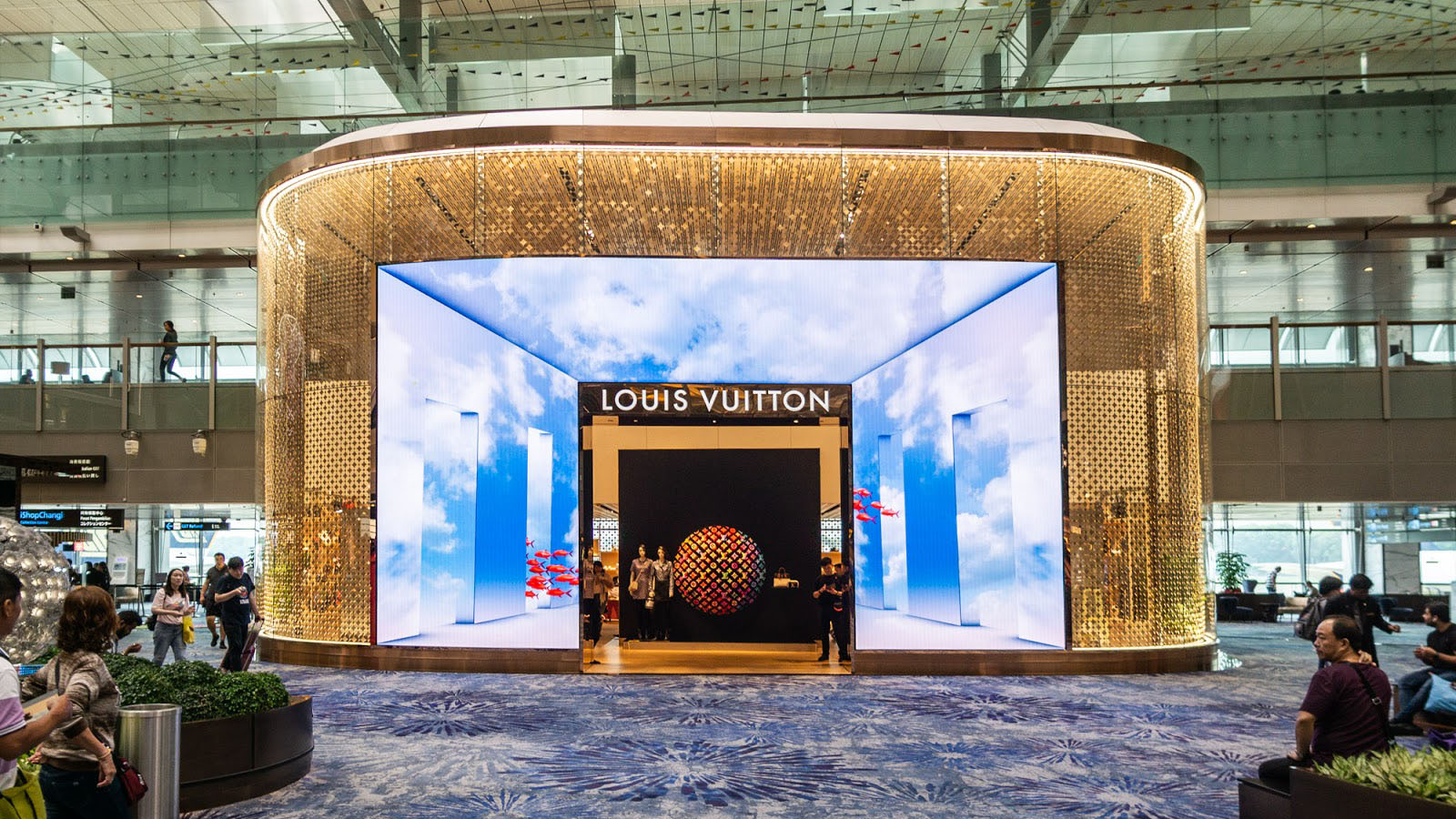
Lounges and Singapore Food Street are all located up one floor, just like the other terminals. In order to streamline security, there are quite a few gate areas that share one security checkpoint. This can result in long lines, although Singapore Airlines has priority screening lanes for Business and First Class.
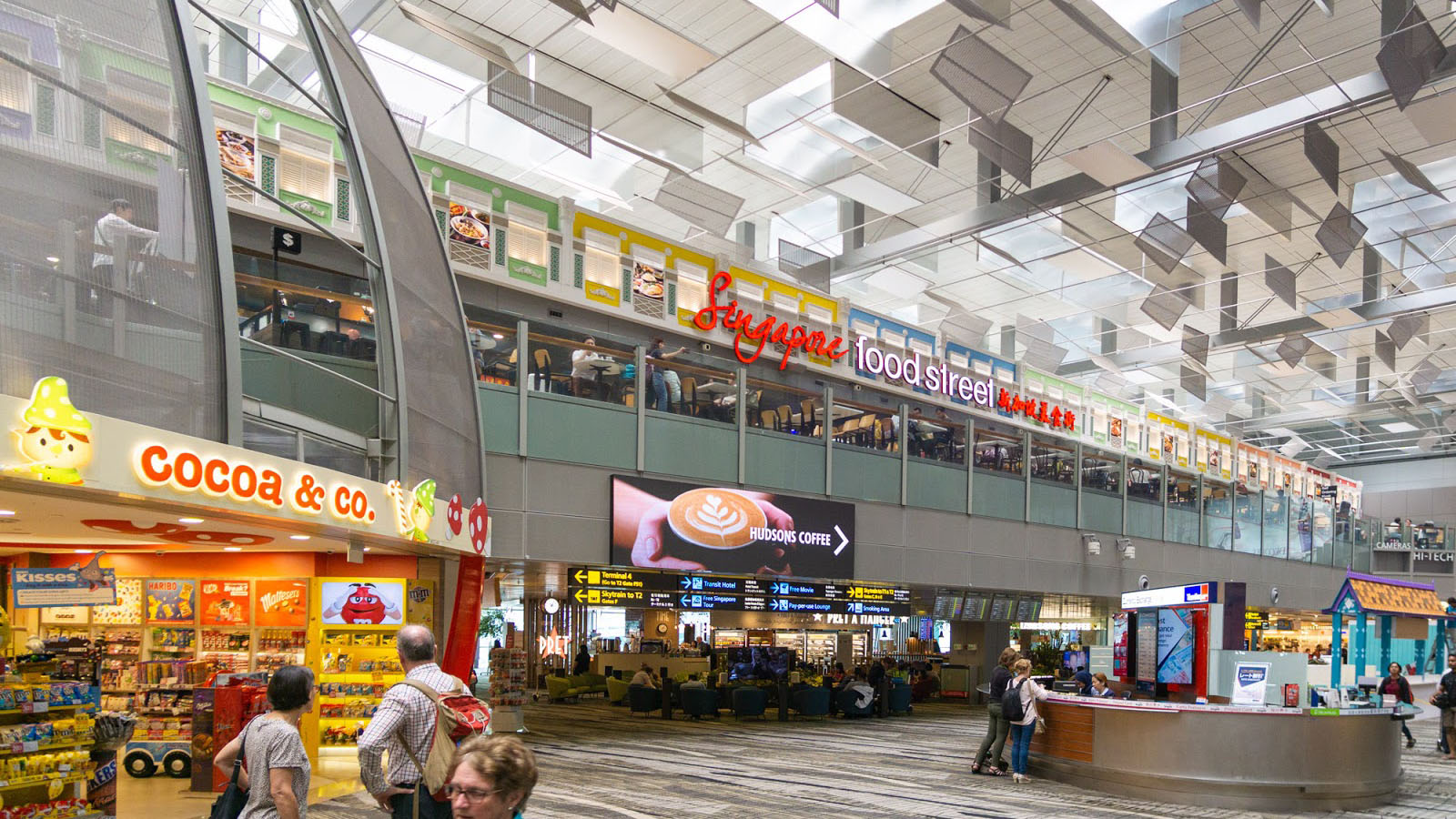
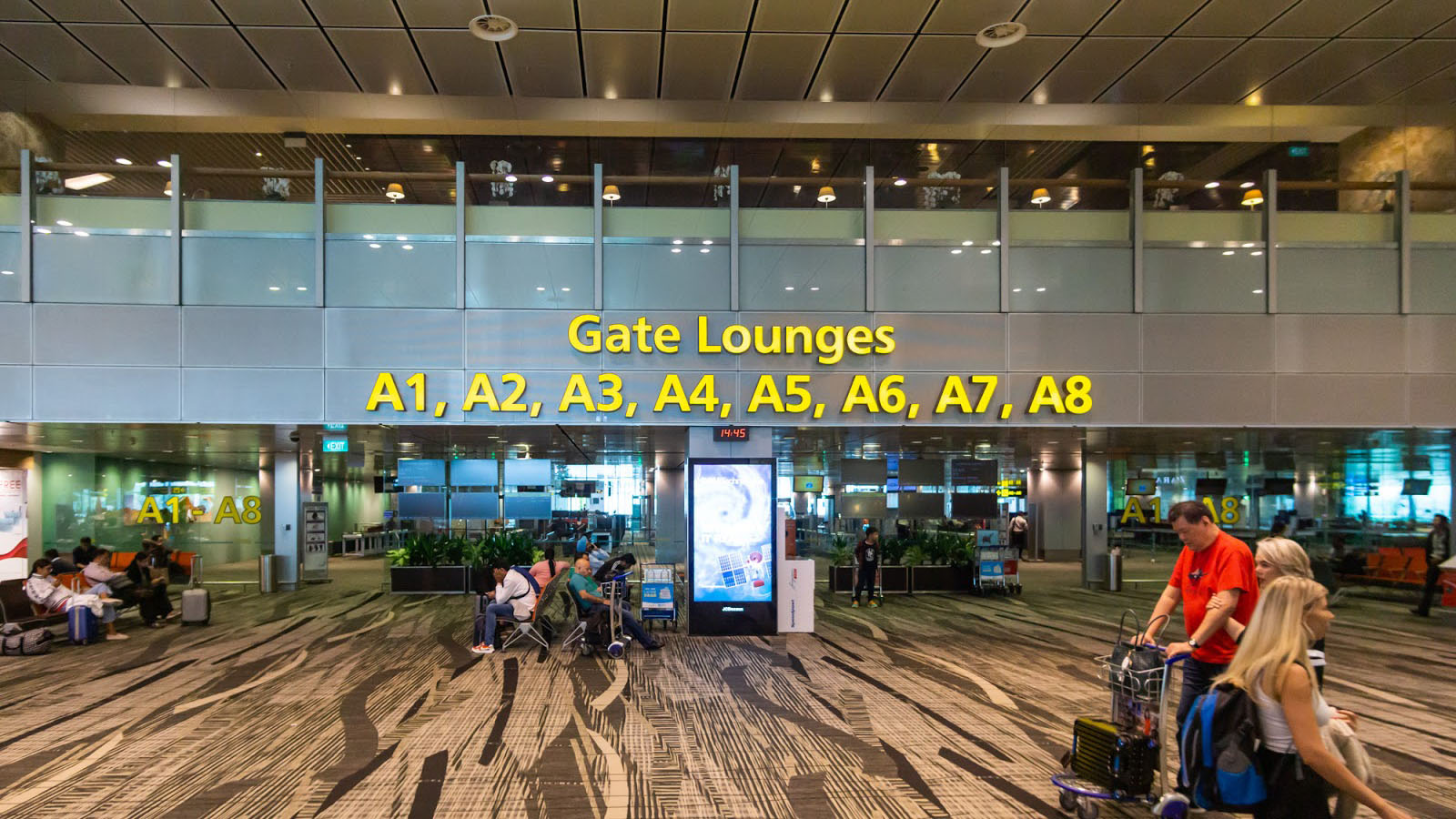
Terminal 3 also has a small movie cinema, playing some of the latest home releases. It’s completely free to stop by, and screenings run 24/7 except during designated cleaning hours. You can view the screening schedule here.
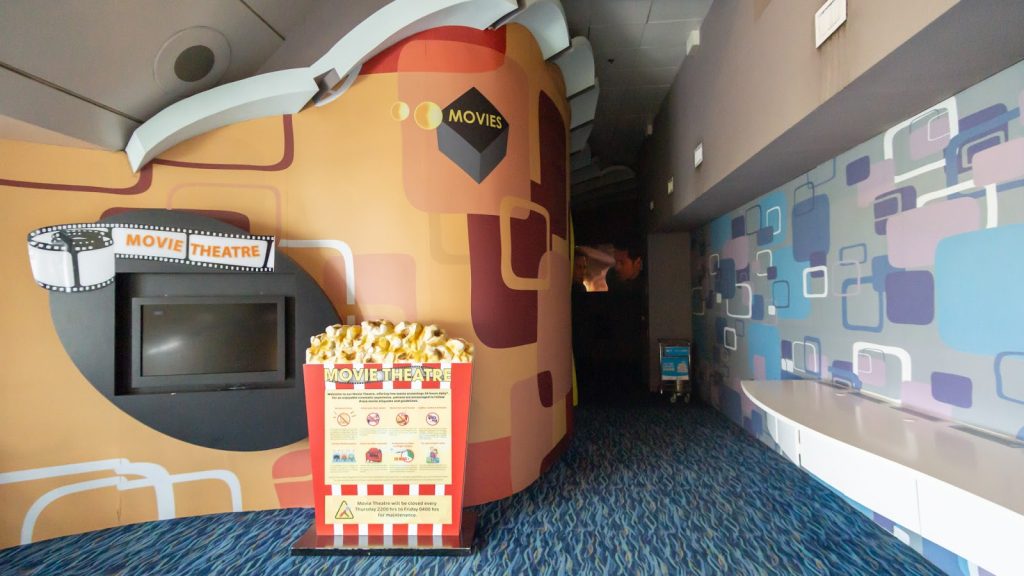
The Crowne Plaza Changi hotel is located landside near Terminal 3, which is really convenient for overnight stays. T3 is also where you’ll find Changi’s butterfly garden.
Terminal 4
Terminal 4 is the odd one out. That’s because it’s Singapore’s newest terminal, but also separate from the Terminal 1/2/3 complex. T4 does things a little differently, with centralised security screening straight after immigration, whereas Terminals 1/2/3 aren’t not sterile until the gates, where security screening takes place.
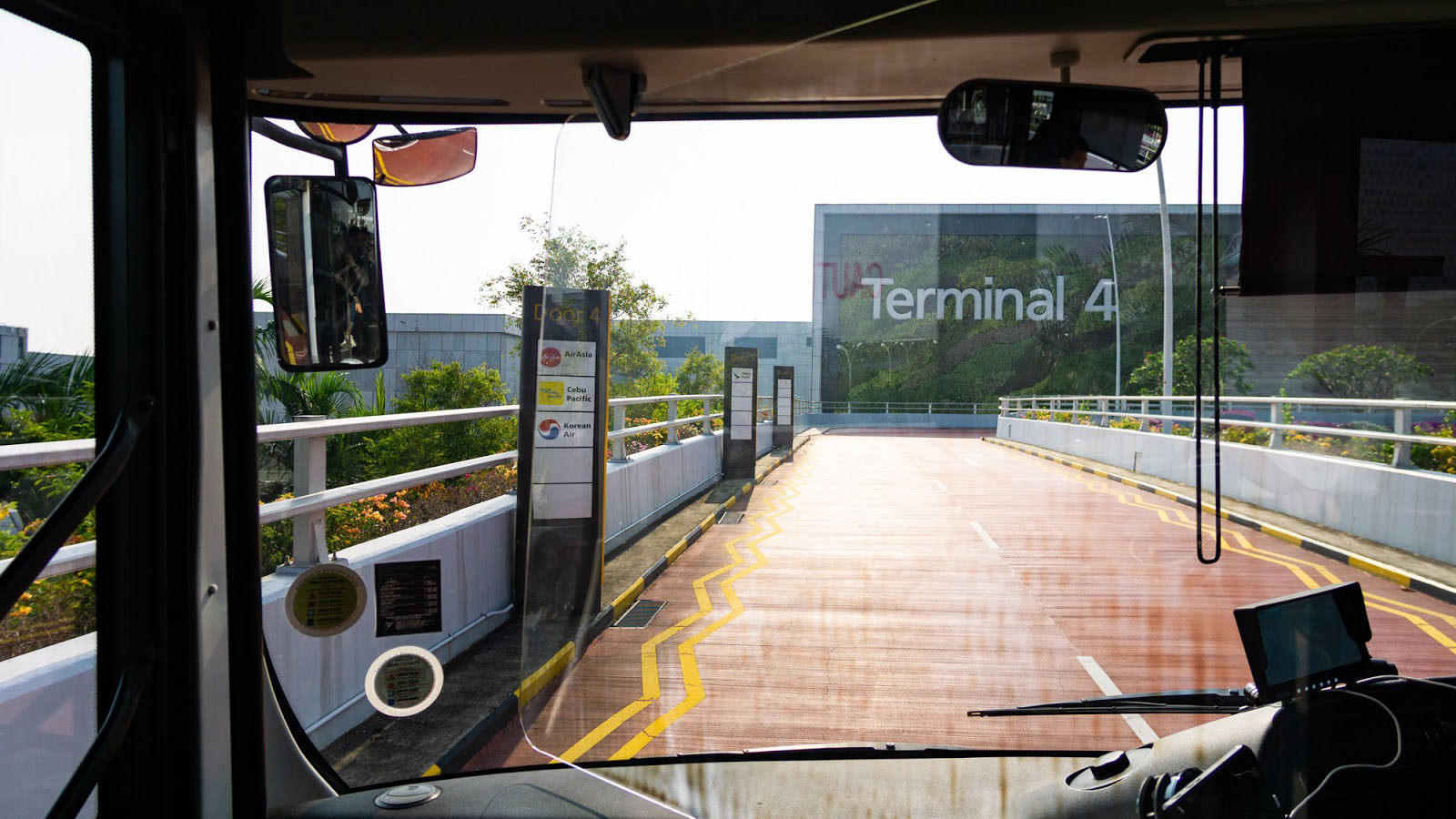
As a new terminal, it was built with automation in mind. The majority of check-in and bag drop is self serve, especially with major low-cost airline anchor Air Asia.
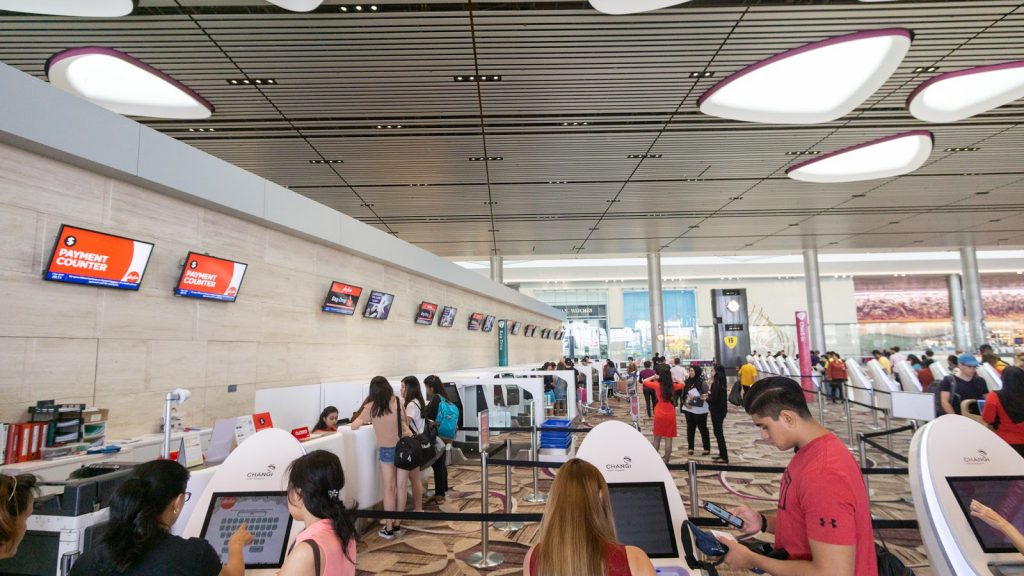
Immigration and boarding are also automated, where possible. Facial recognition technology captures your face at immigration, which is then used to open the boarding gate later.
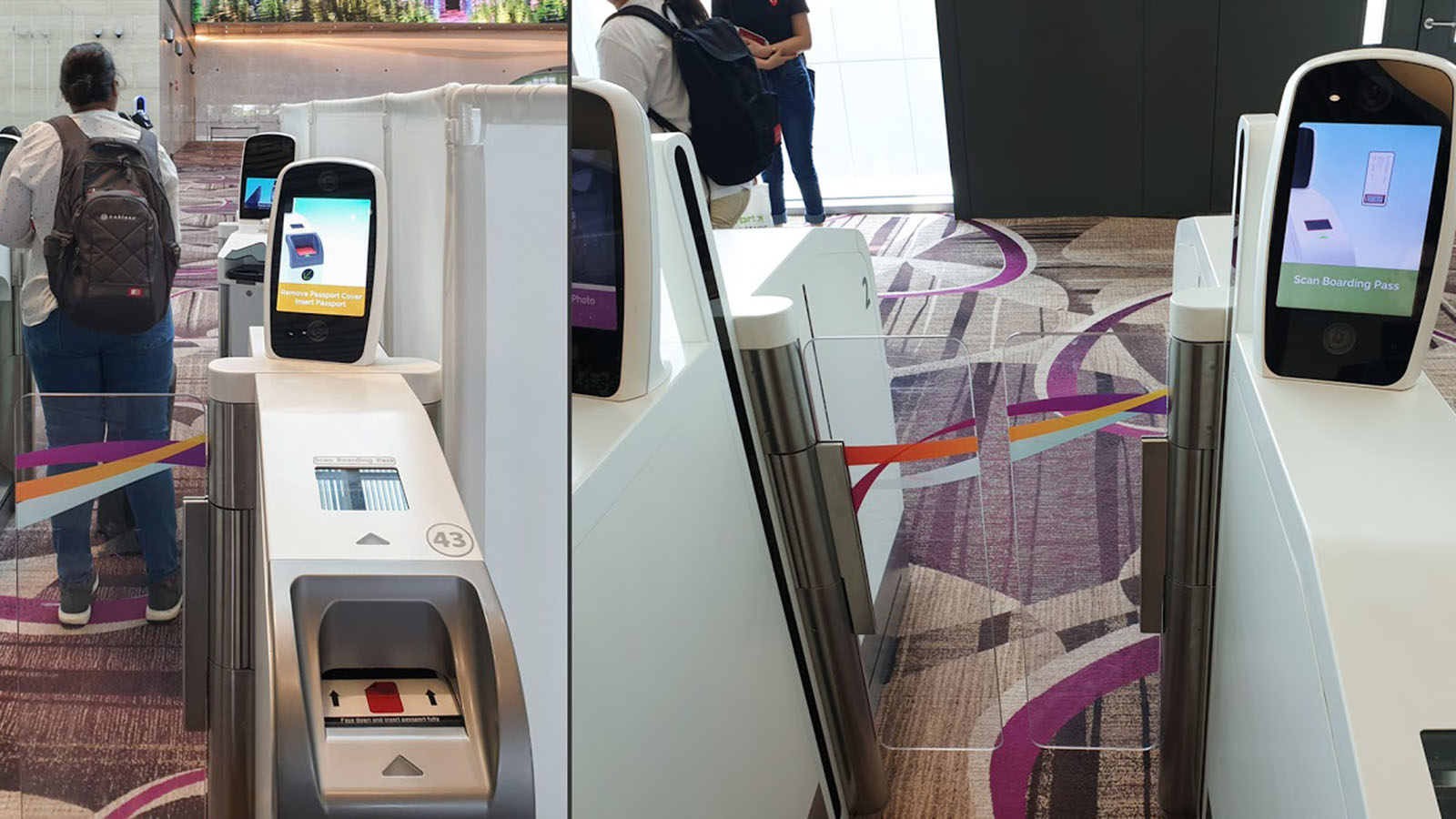
Terminal 4 also features CT scanning security equipment, which makes it a breeze. Laptops and other items don’t usually need to be removed for screening, which helps a lot.
The terminal itself is cavernous. The top floor houses the Blossom – SATS and Plaza Premium Lounge and the Cathay Pacific lounge. These are the only two lounges in the terminal.

Unlike the other three bustling terminals, Terminal 4 has an air of peace and tranquillity. It’s quiet because it doesn’t serve as many airlines for now, so it’s not at full capacity.

The downside of having security at each gate in Terminals 1/2/3 is that the spaces feel claustrophobic. In contrast here, the gate areas are very spacious and relaxing.
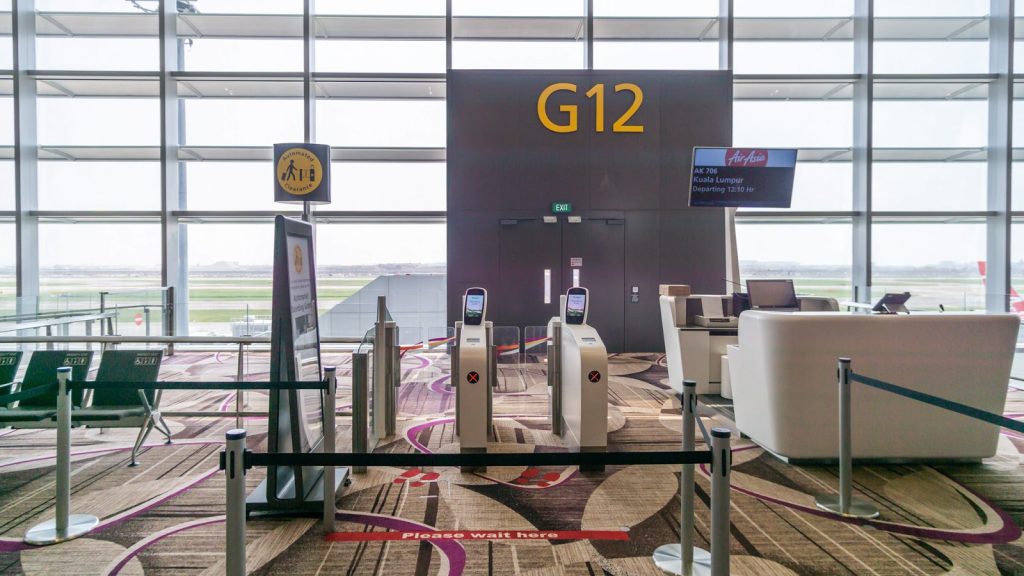
Immigration at Singapore Changi Airport
Prior to landing in Singapore, you’ll need to complete Singapore’s electronic arrivals form – the SG Arrival Card. But here’s a hot tip. If you don’t have checked luggage and are arriving at Terminals 1, 2 or 3, you can actually go to one of those other terminals and clear immigration there.
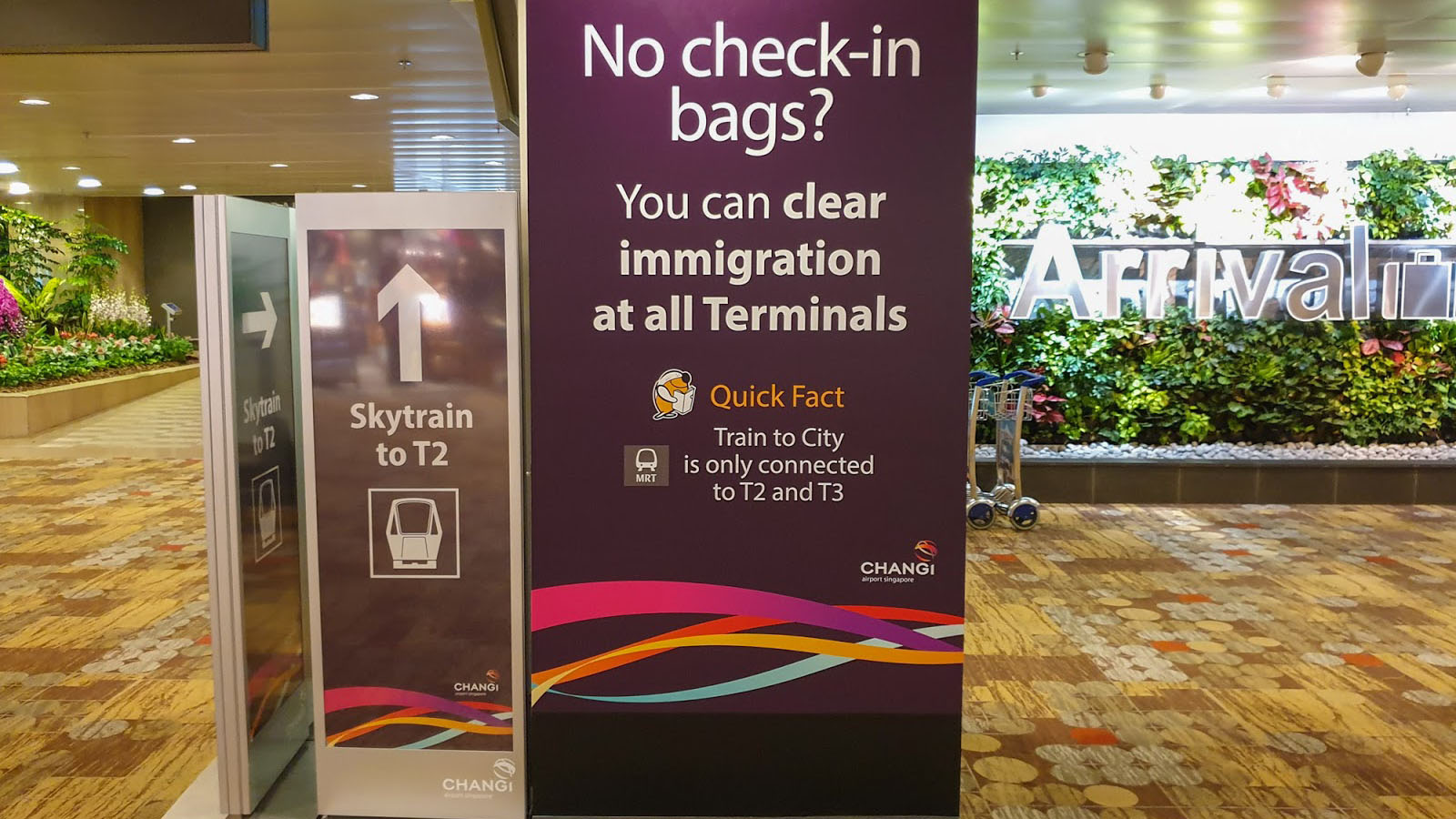
Why would you want to do that, you might ask? Each terminal has different waves of ‘peak times’, and it could be much quieter at a different terminal. It only takes minutes to ride the Skytrain to a quieter terminal, potentially saving quite a bit of time at processing (though it can be a bit of a gamble).
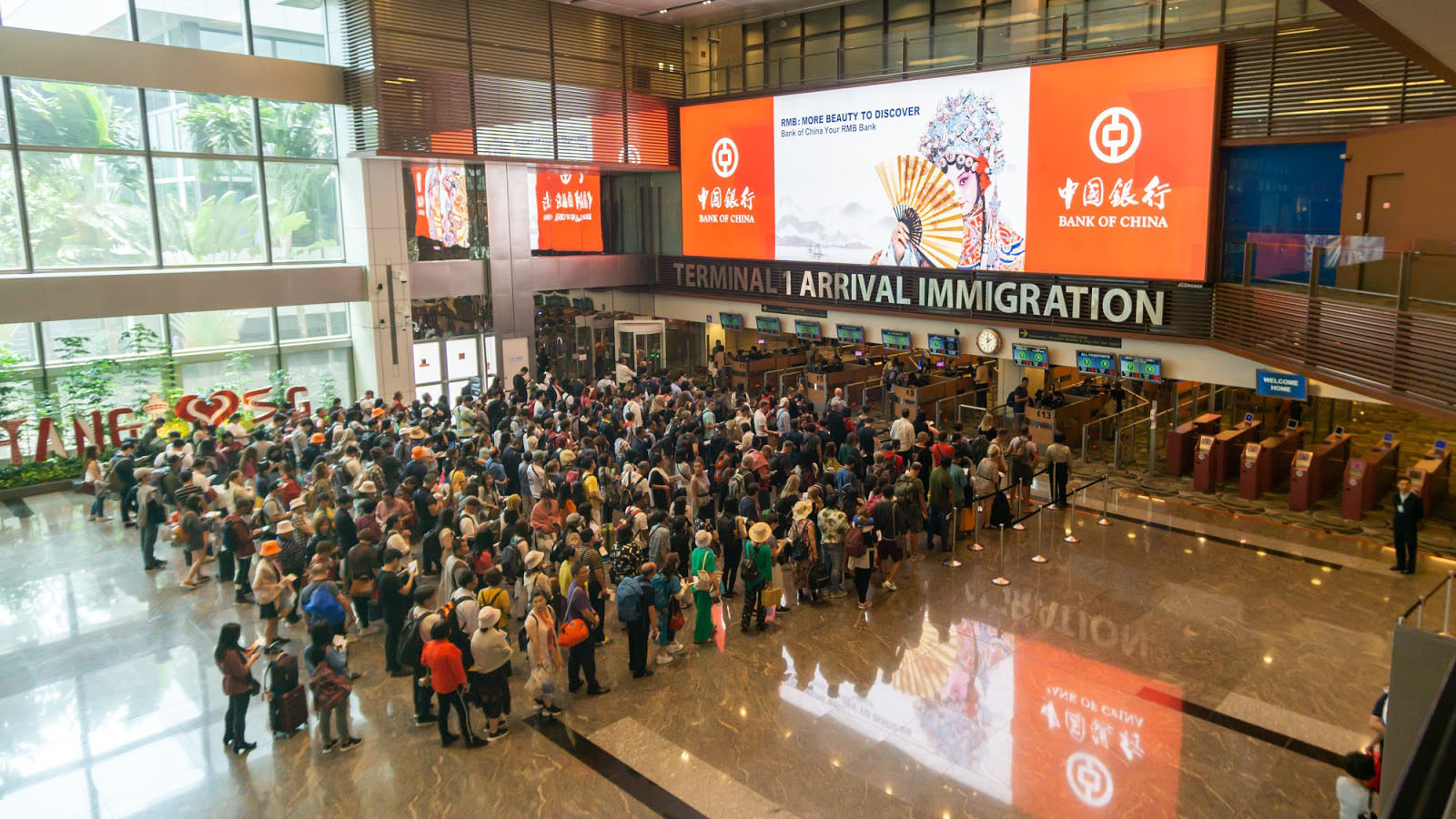
The free Singapore transit tour
Did you know that if you have a long layover at Singapore Changi Airport that doesn’t involve going through immigration, you can actually get a free 2.5-hour tour of Singapore?
You’ll need between 5.5 and 24 hours between flights, no more and no less. All the information can be found online here, but as a summary, you need to be eligible to enter Singapore to participate. You’ll also need to pre-register for the tour, or sign-up in person at the T2 or T3 transit area. The meeting points are also within the T2/T3 transit area, so do not exit immigration until you’re with the tour group.

Getting to and from Singapore Changi Airport
In terms of public transport, there are many buses running into the city. There’s also an airport MRT (subway) station in between Terminals 2 and 3. There is no extra airport fee for the MRT. Conveniently, you can simply tap a Mastercard or Visa credit card to ride public transport in Singapore. You don’t need to get a pre-paid card or buy a paper ticket.
Otherwise, taxis are plentiful, and you can also rideshare through Grab, the local app (Uber no longer operates in Singapore). It’s really easy to use, accepts Australian credit cards, and is almost identical to Uber. Most upscale hotels in Singapore can also arrange airport transfers.
How to visit or transit through Singapore with points
There are many ways to visit Singapore using frequent flyer points, from the opulence of Singapore Airline’s new Airbus A380 Suites to Qantas and Emirates’ range of flights in Business and First Class.
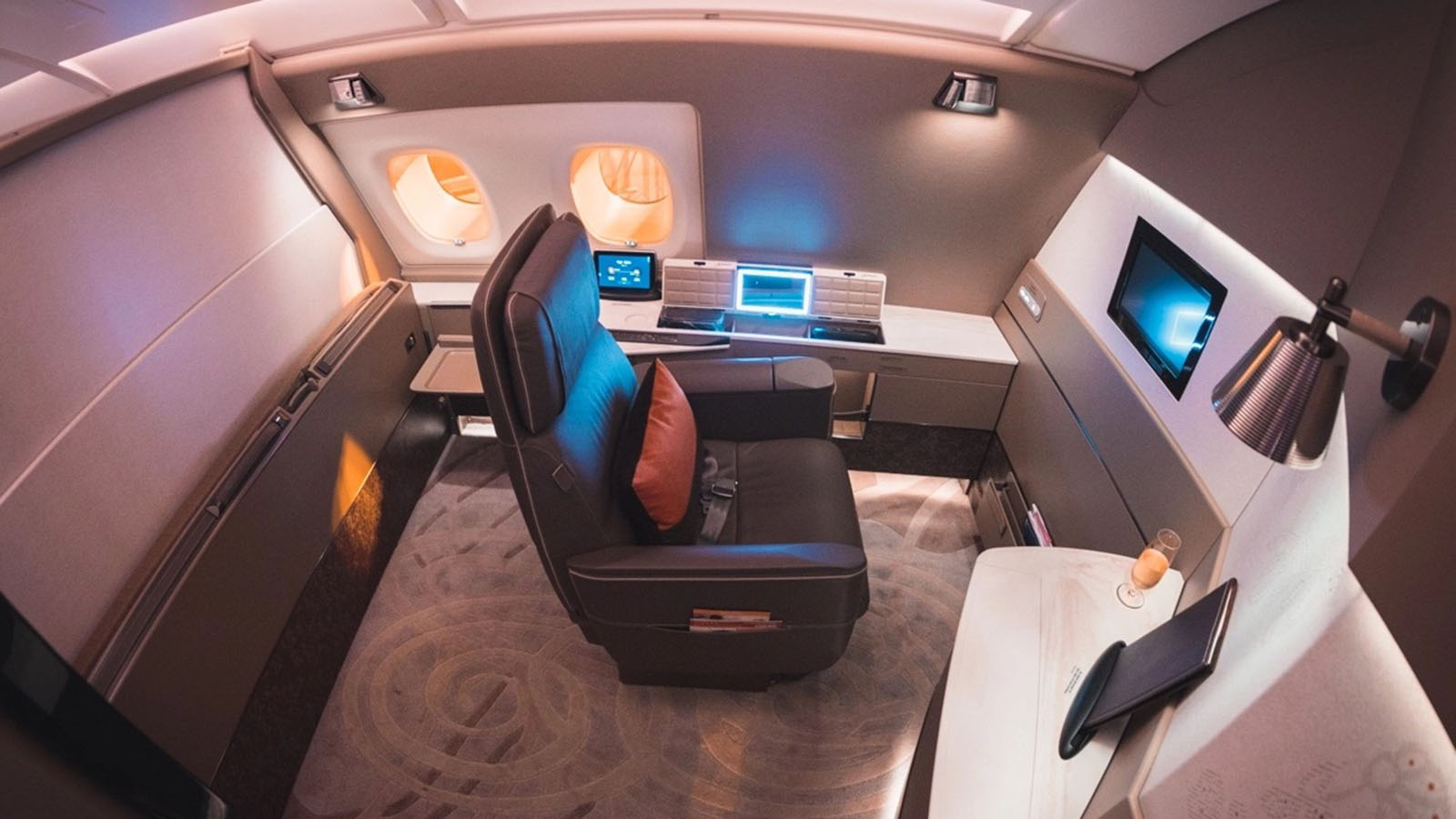
It’s also possible to book flights with British Airways (from Sydney) and Jetstar (from Melbourne) using Qantas Points. Additionally, Jetstar is returning to the Perth-Singapore route from August 2024. A more recent entrant is Turkish Airlines between Melbourne and Singapore, which can be booked using KrisFlyer miles.
Summing up
Changi Airport really has a wealth of features and amenities to keep both kids and adults entertained. There are lots of other facilities and shops throughout the complex too, which we’ll summarise here.
All terminals have lots of duty-free shopping. Assuming you can take these to your next destination, liquids will be delivered to gate security in T1/2/3. There are, of course, plenty of restroom facilities, all equipped with high-tech sensors, and for some of them, killer views!
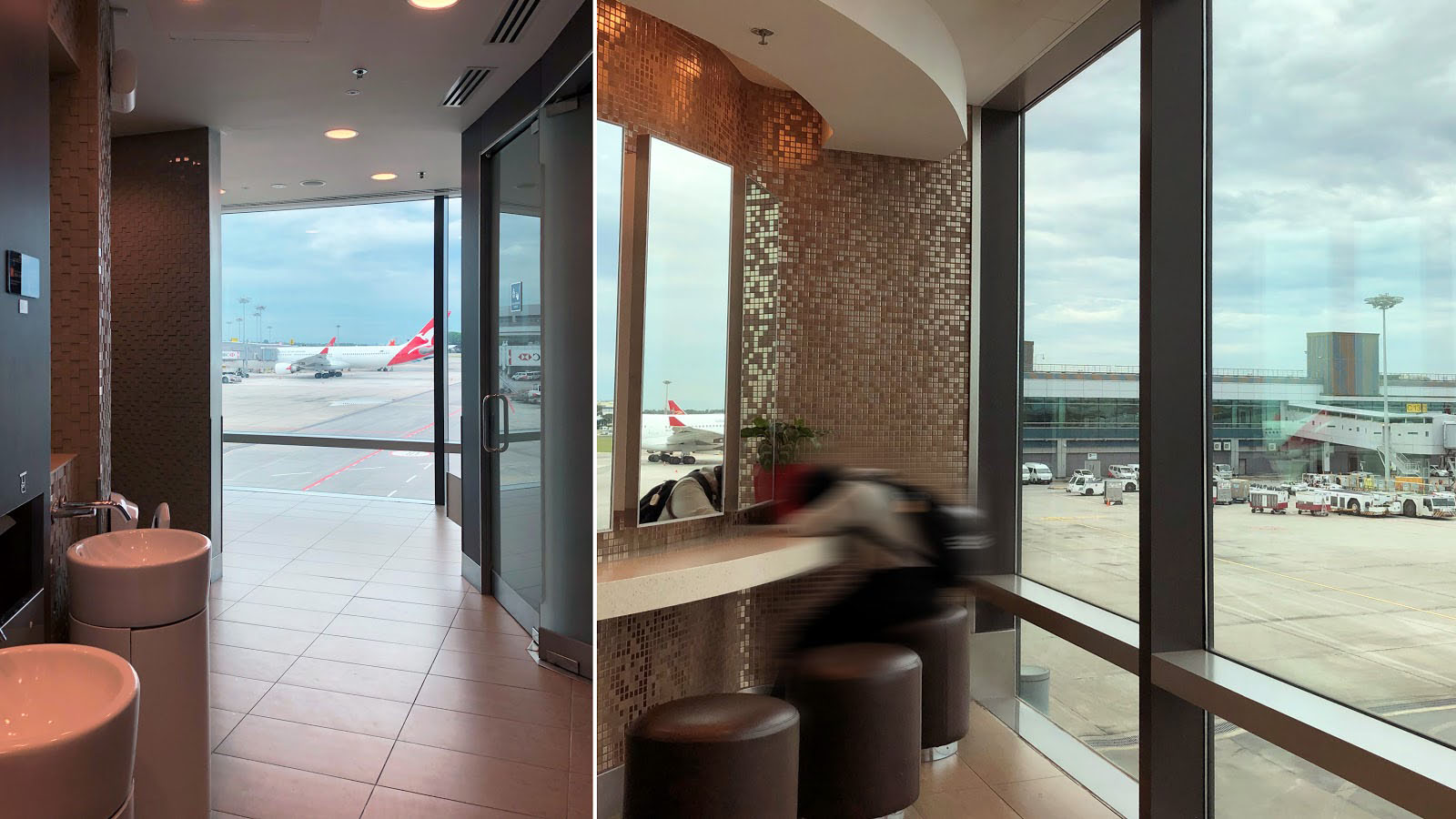
If you need a nap but don’t want to use one of the many transit hotels, there are a few free sleeping lounges with semi-flat recliners. They are always in high demand though, so you might need to wait around for one to become available.
Free Wi-Fi is offered throughout all terminals, as well as charging points with cables and computers with internet access, in case you didn’t bring your own gear.
There are plenty of art installations and attractions that will wow adults and kids alike, such as Kinetic Rain (1,216 bronze rain droplets moving like water), and the world’s tallest slide inside an airport (located in Terminal 3). Visit here for the full list of attractions.
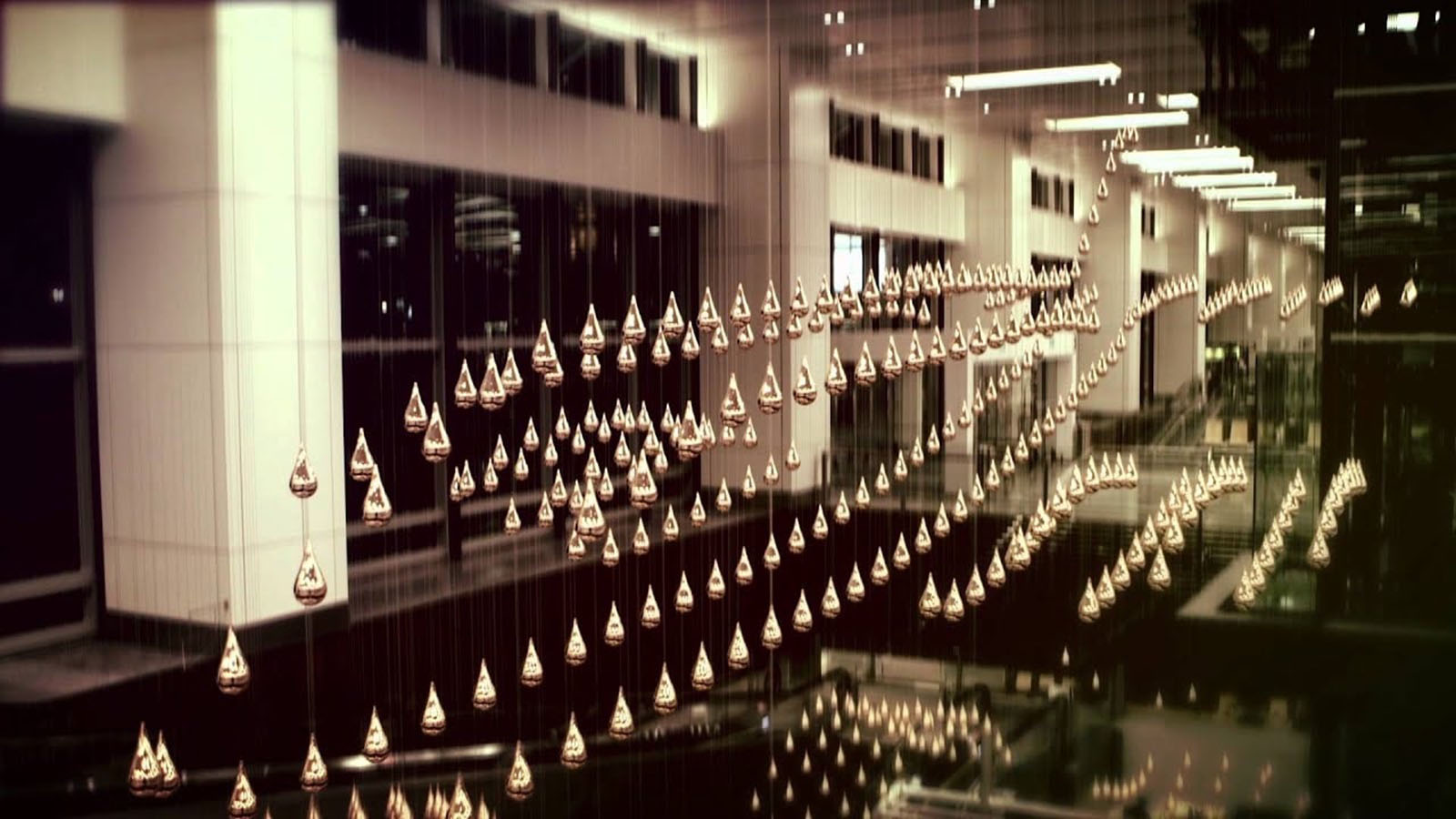
While Changi is a great airport to depart from or transit through, there is one noticeable downside. That’s having security at the gates in T1/2/3, which means leaving the lounge early to get boarding on time. But there are upsides to this arrangement as well, such as having access to the shops and facilities as an arriving passenger. The airport can also customise the level of screening required based on each destination. And, in the rare event of a security breach that requires passengers to be rescreened, this would only affect one gate area, not the entire terminal.
Photography and original reporting by Evin Tan Khiew.

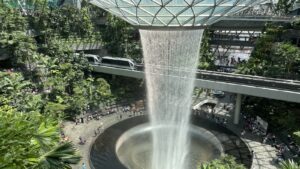
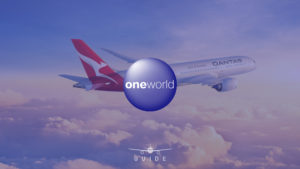
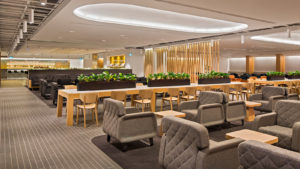


Bring back the Orchids ! they were such a great present to pick up on the way to the UK !